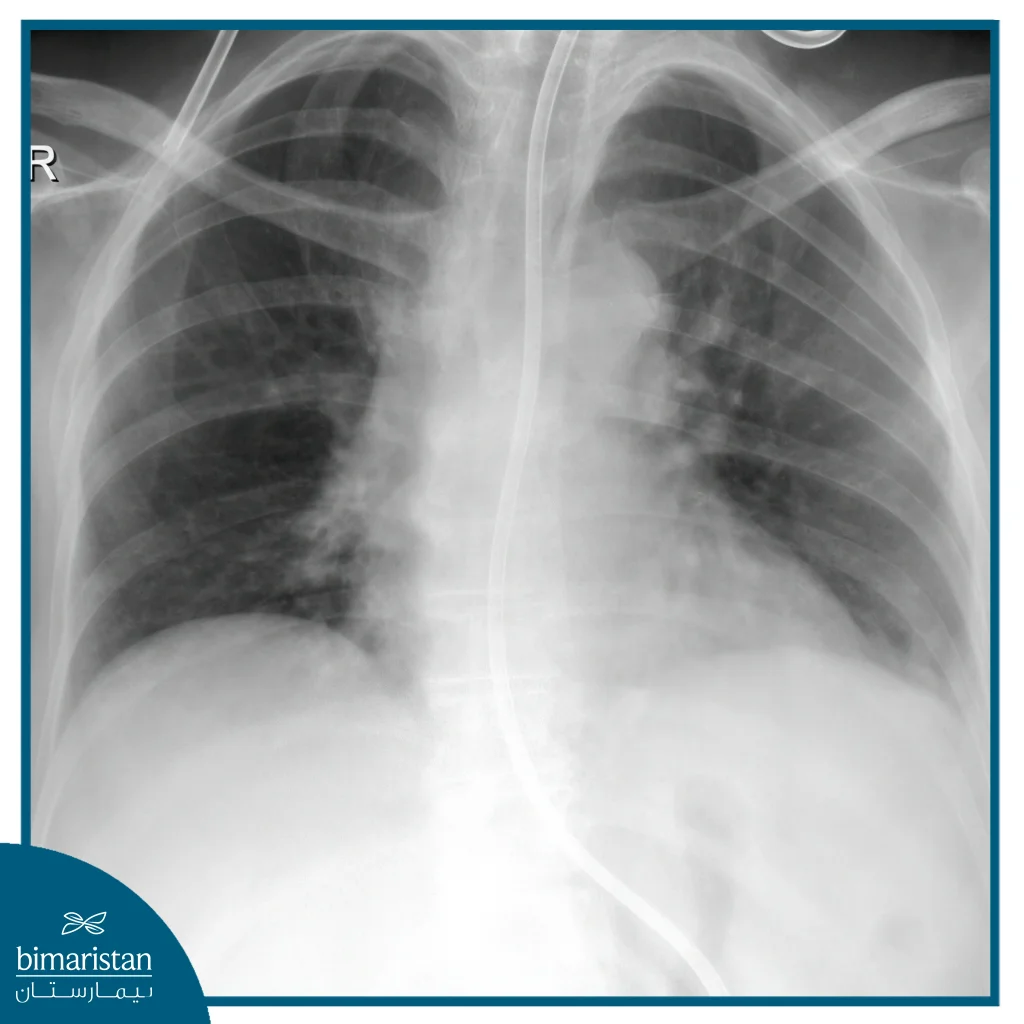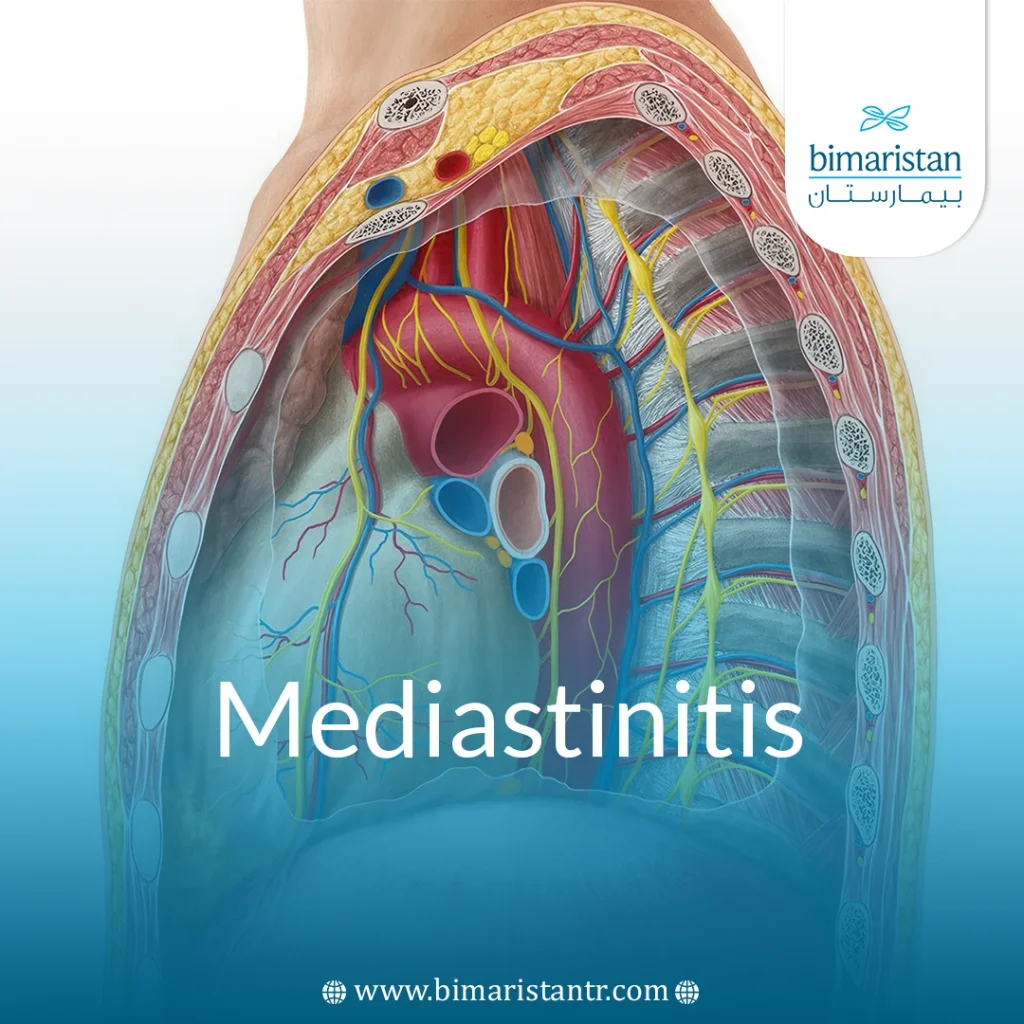The mediastinum is the anatomical space located in the center of the chest between the lungs and contains vital organs including the heart, large vessels, trachea, esophagus, and thymus.
Mediastinitis is a rare but serious condition that usually occurs as a result of an acute bacterial infection after chest surgery or esophageal rupture. The infection causes severe chest pain, fever, and difficulty breathing and can quickly lead to life-threatening complications, so early diagnosis and prompt therapeutic intervention is important to improve the chances of recovery and minimize complications.
What is mediastinitis?
Mediastinitis is a serious inflammation of the tissues in the mediastinum, which is the area in the middle of the chest between the lungs, usually caused by a bacterial infection and often appears after open heart surgery or as a result of a tear in the esophagus that allows bacteria to enter the mediastinum, and is characterized by severe symptoms that include severe chest pain, high fever, difficulty breathing and rapid heartbeat, there are two main types of mediastinitis:
- Acute inflammation: This is the most common as it develops quickly and requires immediate treatment, often associated with chest surgery or esophageal injuries.
- Chronic inflammation: It is less common and develops slowly, may be caused by a fungal or tuberculous infection, and is usually seen in immunocompromised patients or in some chronic conditions.
Although mediastinitis is not common, its occurrence is a medical emergency, and its severity increases due to the presence of important vital organs in this area, making delayed diagnosis and treatment a cause of high mortality rates.
What causes mediastinitis?
Mediastinitis is a rare and serious condition that is often caused by an infection or injury to the chest or esophagus. Understanding the possible causes helps in early diagnosis and prompt treatment:
- Complications after thoracic surgery (especially open heart surgery): These are caused by wound infection after sternotomy and can be life-threatening.
- Esophageal perforation (as a result of endoscopy or external injury): Leads to leakage of esophageal contents into the mediastinum and rapid acute inflammation.
- Infection from the neck or teeth: A deep neck infection or oral abscess may spread to the mediastinum through the tissues.
- Disseminated hematogenous infection: A rare occurrence in which bacteria travel through the blood to the mediastinum and cause life-threatening inflammation.
Common symptoms of mediastinitis
Mediastinitis can appear with a range of signs and symptoms that reflect the impact on neighboring tissues and organs. Early detection of these symptoms facilitates diagnosis and speeds up the start of treatment, among the most important of these symptoms:
- Severe chest or back pain: Often sudden and accompanied by a burning sensation.
- Fever and chills (shivering): A sign of an active infection.
- Difficulty breathing or swallowing: Due to swelling or pressure on the airways and esophagus.
- Swelling in the neck or chest: May indicate a spreading infection or a buildup of pus.
- Signs of generalized inflammation: Such as a rapid heartbeat (tachycardia) and low blood pressure, reflect the body’s response to a severe infection.
How is mediastinitis diagnosed?
The medical evaluation begins with several integrated steps that aim to accurately determine the presence and causes of inflammation, the most important of which are
- Clinical examination: The doctor makes a thorough assessment of the patient’s symptoms, such as chest pain, fever, and difficulty breathing, and looks for visible signs such as swelling in the neck or chest or signs of systemic infection.
- Blood tests: These are used to check for the presence of acute infections and an elevated leukocyte count and CRP, indicating an infection or an active inflammatory response.
- Radiography: It starts with a chest X-ray to look for air or fluid in the mediastinum, but a computerized tomography (CT) scan is more accurate as it shows pus collections, air leaks, or obvious signs of inflammation.
- Endoscopy (if needed): Esophagoscopy or bronchoscopy is used when a perforation or rupture is suspected to accurately identify the source and guide a surgical or medical treatment plan.

Mediastinitis treatment methods
Mediastinitis treatment requires urgent medical intervention as it combines pharmacological and surgical treatment and is a condition that is usually treated in the hospital under the supervision of a multidisciplinary team:
Intravenous antibiotic therapy
Intravenous antibiotic therapy is the main line of treatment, using high-dose broad-spectrum antibiotics directly intravenously, and early administration is an important factor in preventing the spread of infection and minimizing systemic complications.
Surgical intervention
In cases where an abscess or dead tissue is detected, surgery is performed to drain the pus and clean the mediastinum. Possible procedures include mediastinotomy or thoracotomy, depending on the location and severity of the infection.
Supportive care
ICU care for severely infected patients includes respiratory support, blood pressure control, and monitoring of vital signs, especially in cases of sepsis or organ failure.
What are the complications of neglecting mediastinitis?
Neglecting mediastinitis or delaying its treatment can lead to serious life-threatening complications, especially in severe cases or accompanied by severe infection, the most important of which are:
- Sepsis is a common life-threatening inflammatory condition that occurs when an infection enters the bloodstream.
- The infection spreads to the lungs or pericardium: This can result in pericardial effusion, a buildup of fluid around the heart that affects how well it pumps blood.
- Respiratory failure: The result of pressure on the airways or damage to lung tissue caused by infection.
- Possible death if not treated quickly: Acute mediastinitis can be fatal within days if not treated urgently.
Prevention and management after surgery
To prevent mediastinitis, especially after open-heart or chest surgeries, it is recommended to follow strict protocols for sterilization during and after surgery. It is important to monitor the operation wound regularly for any signs of infection, such as redness, swelling, or abnormal discharge, and extreme caution after any procedure on the esophagus or airways (such as endoscopy or intubation,) as perforation or leakage may lead to the entry of germs into the mediastinum. Adherence to home care instructions and medical follow-up, especially in diabetic or immunocompromised patients, is essential to minimize the risk of complications.
Mediastinitis is a serious medical condition that requires prompt intervention to avoid complications such as sepsis or respiratory failure. Early diagnosis and appropriate treatment, including intravenous antibiotics and surgical intervention, significantly improve outcomes. Adherence to post-operative care and careful monitoring of symptoms play a crucial role in significantly reducing the risk of mediastinitis.
Sources:
- National Center for Biotechnology Information. (2020). Mediastinitis. In StatPearls. StatPearls Publishing.
- MedlinePlus. (n.d.). Pericarditis. U.S. National Library of Medicine.

